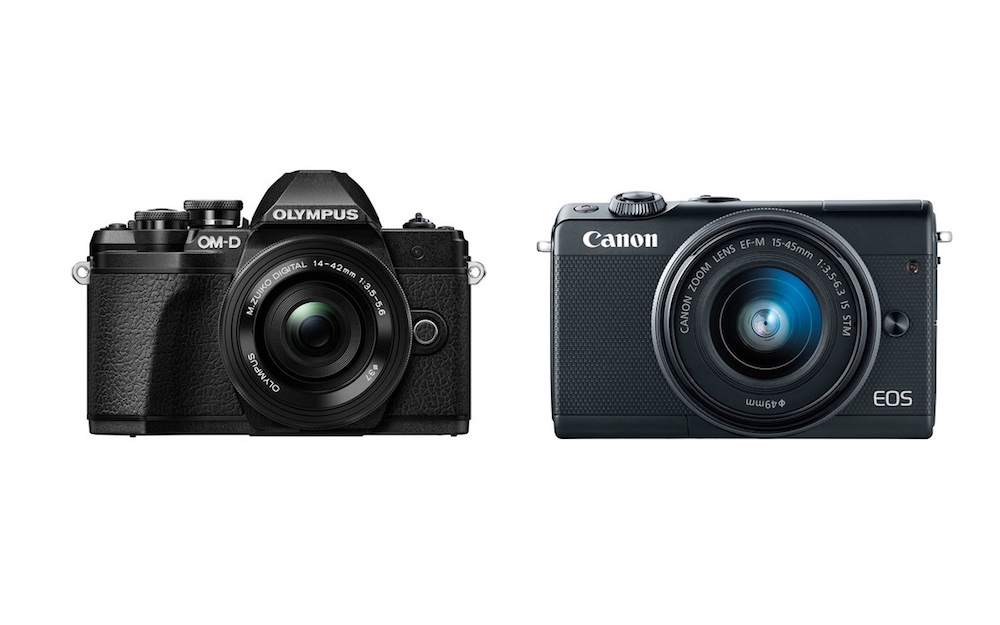Here is the quick review and comparison of Olympus E-M10 III vs Canon EOS M100. In this article you can find the key differences between these entry-level mirrorless cameras.
The Olympus E-M10 Mark III has a 16.1-megapixel Four Thirds CMOS sensor powered by a dual quad-core TruePic VIII Processor. There’s 4K video recording and the continuous shooting goes up to 8.5 frames per second. The Micro Four Thirds camera is selling for $650 body only. See the first tests with samples.
The EOS M100 brings 24.2MP sensor with Dual Pixel autofocus to the Canon’s entry-level mirrorless range for the first time. Improvements over the M10 are the DIGIC 7 processor as well as 1080/30p to 1080/60p video capture and 4 fps burst shooting with continuous AF (6 fps with single AF).
So what may be the main differences when consider Olympus E-M10 III vs Canon EOS M100 specs list?
Differences between Olympus E-M10 III vs Canon EOS M100 Cameras
Let’s compare the Olympus E-M10 III vs Canon EOS M100. Our comparison table below covers all the important specifications of each camera.
If you’re trying to decide which one to buy as your first camera, here are the differences of Olympus E-M10 III vs Canon EOS M100 cameras.
Olympus E-M10 III vs Canon EOS M100 Comparison Table
| Features | Olympus E-M10 III | Canon EOS M100 |
|---|---|---|
| Sensor resolution | 16.1 Live Mos | 24.2 APS-c CMOS Sensor |
| AA Filter | N/A | Yes |
| Max Image Resolution | 4608 x 3456 | 6000 x 4000 |
| Image Stabilization | 5-axis | 3-axis |
| ISO | Auto 200 – 25,600 | Auto 100 – 25,600 |
| AF System | Contrast Detection: 121 | Hybrid PDAF/CDAF: Dual Pixel CMOS AF; Maximum 49 AF points |
| LCD | 3.0″ 1,040,000 dots Articulating Touchscreen LCD | 3.0″ 1,040,000 dots Tilting Screen LCD |
| Viewfinder | EVF 0.62x magnification 100% coverage |
None |
| Shutter Speed | 60-1/16000 sec | 30-1/4000 sec |
| Built-in Flash | Yes | Yes |
| Burst Speed | 8.5fps | 6.1fps |
| Exposure Compensation | +/- 5.0EV in 0.3EV steps | +/- 3.0EV in 0.3EV steps |
| Video Recording (max. res) |
4K UHD/30p, 25p, 24p | 1920 x 1080 |
| Time Lapse | Yes | No |
| Jpeg Buffer Size | unlimited | 89 |
| RAW Buffer Size | 33 | 25 |
| Mic Input | Yes | No |
| Headphone Jack | No | No |
| Wireless Connectivity | Wi-Fi | Wi-Fi |
| USB Charge | Yes | Yes |
| Environmentally Sealed | No | No |
| Battery Life | 330 shots | 295 shots |
| Dimensions | 122 x 84 x 50 mm | 108 x 67 x 35mm |
| Weight | 503 g | 302 g |
| Price | $650 | $599 |
Conclusion
The sensor size of both cameras are different. The EOS M100 uses APS-c sized image sensor and the E-M10 III comes with Micro 4/3rds. Both cameras are priced around $600 mark.
Olympus E-M10 III is a great entry-level camera that features 4K video recording and 8.5fps burst shooting. On the other hand, Canon EOS M100 doesn’t look fresh against the E-M10 III.
For beginners who are much desperate to get a camera with 4K video in a budget-friendly price should go with Olympus E-M10 III.

